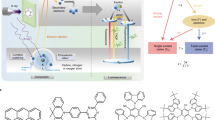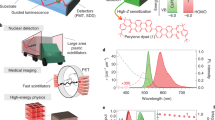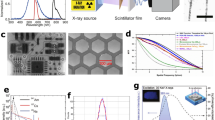Abstract
Efficient and fast scintillators are in high demand in a variety of fields, such as medical diagnostics, scientific instruments and high-energy physics. However, the trade-off between high scintillation efficiency and fast timing properties is a common challenge facing almost all scintillators. To overcome this limitation, we have developed a strategy for organic scintillators by directing all hot excitons into fast singlet emission states without involving the lowest triplet states. Our scintillator, 1,1,2,2-tetrakis(4-bromophenyl)ethylene, shows an ultrafast radiative lifetime of 1.79 ns and a light yield of ∼34,600 photons per MeV, exhibiting an excellent combination of high light yield and short decay time. Our work provides a method to design efficient and ultrafast scintillators, and paves the way towards exciting applications for ultrafast detection and imaging.
This is a preview of subscription content, access via your institution
Access options
Access Nature and 54 other Nature Portfolio journals
Get Nature+, our best-value online-access subscription
$29.99 / 30 days
cancel any time
Subscribe to this journal
Receive 12 print issues and online access
$209.00 per year
only $17.42 per issue
Buy this article
- Purchase on Springer Link
- Instant access to full article PDF
Prices may be subject to local taxes which are calculated during checkout




Similar content being viewed by others
Data availability
The main data that support the findings of this study are available in this Article and its Supplementary Information. Additional data are available from the corresponding authors upon reasonable request. Crystallographic data for TPE-4Br have been deposited at the Cambridge Crystallographic Data Centre under deposition number CCDC 1837774. A copy of the data can be obtained free of charge via https://www.ccdc.cam.ac.uk/structures/.
References
Roques-Carmes, C. et al. A framework for scintillation in nanophotonics. Science 375, eabm9293 (2022).
Chen, Q. et al. All-inorganic perovskite nanocrystal scintillators. Nature 561, 88–93 (2018).
Ziegler, S. I. Positron emission tomography: principles, technology, and recent developments. Nucl. Phys. A 752, 679–687 (2005).
Gandini, M. et al. Efficient, fast and reabsorption-free perovskite nanocrystal-based sensitized plastic scintillators. Nat. Nanotechnol. 15, 462–468 (2020).
Autrata, R., Schauer, P. & Kuapil, J. A single crystal of YAG—new fast scintillator in SEM. J. Phys. E 11, 707 (1978).
Fabjan, C. W. & Ludlam, T. W. Calorimetry in high-energy physics. Annu. Rev. Nucl. Part. Sci. 32, 335–389 (1982).
Lecoq, P., Gektin, A. & Korzhik, M. Inorganic Scintillators for Detector Systems: Physical Principles and Crystal Engineering 2nd edn (Springer, 2017).
Lecoq, P., Gektin, A. & Korzhik, M. Inorganic Scintillators for Detector Systems: Physical Principles and Crystal Engineering 2nd edn, 1–41 (Springer, 2017).
Lecoq, P. Development of new scintillators for medical applications. Nucl. Instrum. Methods Phys. Res. A 809, 130–139 (2016).
Kumar, V. & Luo, Z. A review on X-ray excited emission decay dynamics in inorganic scintillator materials. Photonics 8, 71 (2021).
Zaffalon, M. L. et al. Extreme γ-ray radiation hardness and high scintillation yield in perovskite nanocrystals. Nat. Photonics 16, 860–868 (2022).
Hajagos, T. J., Liu, C., Cherepy, N. J. & Pei, Q. B. High‐Z sensitized plastic scintillators: a review. Adv. Mater. 30, 1706956 (2018).
Wang, X. et al. Organic phosphors with bright triplet excitons for efficient X-ray-excited luminescence. Nat. Photonics 15, 187–192 (2021).
Ma, W. et al. Thermally activated delayed fluorescence (TADF) organic molecules for efficient X-ray scintillation and imaging. Nat. Mater. 21, 210–216 (2022).
Wang, J. X. et al. Heavy-atom engineering of thermally activated delayed fluorophores for high-performance X-ray imaging scintillators. Nat. Photonics 16, 869–875 (2022).
Birks, J. B. Scintillations from organic crystals: specific fluorescence and relative response to different radiations. Proc. Phys. Soc. A 64, 874 (1951).
Brooks, F. D. Development of organic scintillators. Nucl. Instrum. Methods 162, 477–505 (1979).
Pan, Y. et al. High yields of singlet excitons in organic electroluminescence through two paths of cold and hot excitons. Adv. Opt. Mater. 2, 510–515 (2014).
Xu, Y., Xu, P., Hu, D. & Ma, Y. G. Recent progress in hot exciton materials for organic light-emitting diodes. Chem. Soc. Rev. 50, 1030–1069 (2021).
Turtos, R., Gundacker, S., Omelkov, S., Auffray, E. & Lecoq, P. Light yield of scintillating nanocrystals under X-ray and electron excitation. J. Lumin. 215, 116613 (2019).
Mykhaylyk, V. B., Kraus, H. & Saliba, M. Bright and fast scintillation of organolead perovskite MAPbBr3 at low temperatures. Mater. Horiz. 6, 1740–1747 (2019).
Yanagida, T., Watanabe, K. & Fujimoto, Y. Comparative study of neutron and gamma-ray pulse shape discrimination of anthracene, stilbene, and p-terphenyl. Nucl. Instrum. Methods Phys. Res. A 784, 111–114 (2015).
Clairand, I. et al. Use of active personal dosemeters in interventional radiology and cardiology: tests in laboratory conditions and recommendations—ORAMED project. Radiat. Meas. 46, 1252–1257 (2011).
Zhao, W. et al. Highly sensitive switching of solid-state luminescence by controlling intersystem crossing. Nat. Commun. 9, 3044 (2018).
Xu, Y. et al. Highly efficient blue fluorescent OLEDs based on upper level triplet–singlet intersystem crossing. Adv. Mater. 31, 1807388 (2019).
Burrows, H. D., Fernandes, M., Melo, J. S., Monkman, A. P. & Navaratnam, S. J. Characterization of the triplet state of tris(8-hydroxyquinoline)aluminium(III) in benzene solution. J. Am. Chem. Soc. 125, 15310–15311 (2003).
Hirata, S. Intrinsic analysis of radiative and room-temperature nonradiative processes based on triplet state intramolecular vibrations of heavy atom-free conjugated molecules toward efficient persistent room-temperature phosphorescence. J. Phys. Chem. Lett. 9, 4251–4259 (2018).
Ikeda, N., Koshioka, M., Masuhara, H. & Yoshihara, K. Picosecond dynamics of excited singlet states in organic microcrystals: diffuse reflectance laser photolysis study. Chem. Phys. Lett. 150, 452–456 (1988).
Merkel, P. B. & Dinnocenzo, J. P. Thermodynamic energies of donor and acceptor triplet states. J. Photochem. Photobiol. A 193, 110–121 (2008).
Bachilo, S. β-Carotene triplet state absorption in the near-IR range. J. Photochem. Photobiol. A 91, 111–115 (1995).
Zhao, W., He, Z. & Tang, B. Z. Room-temperature phosphorescence from organic aggregates. Nat. Rev. Mater. 5, 869–885 (2020).
Reineke, S. & Baldo, M. A. Room temperature triplet state spectroscopy of organic semiconductors. Sci. Rep. 4, 3797 (2014).
Giachino, G. G. & Kearns, D. R. Nature of the external heavy‐atom effect on radiative and nonradiative singlet–triplet transitions. J. Chem. Phys. 52, 2964–2974 (1970).
Russo, P. (ed.) Handbook of X-ray Imaging: Physics and Technology (CRC, 2017).
Auffray, E. et al. Crystal conditioning for high-energy physics detectors. Nucl. Instrum. Methods Phys. Res. A 486, 22–34 (2002).
Ramudu, B. V., Reddy, C. J. & Madhu, V. Flash X-ray radiography technique to study the high velocity impact of soft projectile on E-glass/epoxy composite material. Def. Technol. 15, 216–226 (2019).
Lecoq, P. Pushing the limits in time-of-flight PET imaging. IEEE Trans. Radiat. Plasma Med. Sci. 1, 473–485 (2017).
Turtos, R. et al. Ultrafast emission from colloidal nanocrystals under pulsed X-ray excitation. J. Instrum. 11, P10015 (2016).
Benitez, R. B., Ning, R., Conover, D. & Liu, S. H. Measurements of the modulation transfer function, normalized noise power spectrum and detective quantum efficiency for two flat panel detectors: a fluoroscopic and a cone beam computer tomography flat panel detectors. J. Xray Sci. Technol. 17, 279–293 (2009).
Frisch M. J. et al. Gaussian09 (Gaussian Inc., 2009); http://www.gaussian.com/
Becke, A. D. Density‐functional thermochemistry. I. The effect of the exchange‐only gradient correction. J. Chem. Phys. 96, 2155–2160 (1992).
Kong, J. et al. Q‐Chem 2.0: a high‐performance ab initio electronic structure program package. J. Comput. Chem. 21, 1532–1548 (2000).
Hohenberg, P. & Kohn, W. Inhomogeneous electron gas. Phys. Rev. 136, B864–B871 (1964).
Kohn, W. & Sham, L. J. Self-consistent equations including exchange and correlation effects. Phys. Rev. 140, A1133–A1138 (1965).
Blöchl, P. E. Projector augmented-wave method. Phys. Rev. B 50, 17953–17979 (1994).
Kresse, G. & Joubert, D. From ultrasoft pseudopotentials to the projector augmented-wave method. Phys. Rev. B 59, 1758–1775 (1999).
Kresse, G. & Furthmüller, J. Efficient iterative schemes for ab initio total-energy calculations using a plane-wave basis set. Phys. Rev. B 54, 11169–11186 (1996).
Kresse, G. & Furthmüller, J. Efficiency of ab-initio total energy calculations for metals and semiconductors using a plane-wave basis set. Comput. Mater. Sci. 6, 15–50 (1996).
Perdew, J. P., Burke, K. & Ernzerhof, M. Generalized gradient approximation made simple. Phys. Rev. Lett. 77, 3865–3868 (1996).
Turner, M. J. et al., CrystalExplorer17 (University of Western Australia, 2017).
Acknowledgements
This work was supported by the Major State Basic Research Development Program of China (2021YFB3201000 and 2018YFA0703200), the National Natural Science Foundation of China (62134003, 62074066, U23A20359, 62204092 and 12050005), the Chinese Academy of Sciences Project for Young Scientists in Basic Research (YSBR-024), the Fund for the Natural Science Foundation of Hubei Province (2021CFA036 and 2020CFA034), the Shenzhen Basic Research Program (JCYJ20200109115212546), the HCP Program of Huazhong University of Science and Technology, the Innovation Fund of Wuhan National Laboratory for Optoelectronics and the project funded by the China Postdoctoral Science Foundation (2023T160242), the Innovation Project of Optics Valley Laboratory (OVL2023ZD002). We acknowledge X. Li from Nanjing University of Science and Technology for their help with the X-ray-excited luminescence lifetime characterization, and Y. Gao from China University of Geosciences (Wuhan) for their discussion on the hot exciton emission mechanism.
Author information
Authors and Affiliations
Contributions
J.T. and G.N. supervised the whole project. G.N. conceived the idea. X.D., S.Z. and H.W. carried out most of the material characterization and device optimization. L.W., F.Y., K.-H.X., D.Z. and Z.X. performed the theoretical simulations and analysed the results. S.P. and J.X. carried out the transient absorption characterization. Z.S. performed the CTR measurements and analysed the results. Z.Z. and L.X. assisted in the data analysis. J.T., G.N. and X.D. analysed the results and wrote the paper; all authors commented on the manuscript.
Corresponding authors
Ethics declarations
Competing interests
The authors declare no competing interests.
Peer review
Peer review information
Nature Photonics thanks Qibing Pei, Valery Bliznyuk and the other, anonymous, reviewer(s) for their contribution to the peer review of this work.
Additional information
Publisher’s note Springer Nature remains neutral with regard to jurisdictional claims in published maps and institutional affiliations.
Supplementary information
Supplementary Information
Supplementary Text, Figs. 1–31 and Tables 1–6.
Supplementary Video 1
The bubbling process in solution captured using the TPE-4Br scintillator screen.
Rights and permissions
Springer Nature or its licensor (e.g. a society or other partner) holds exclusive rights to this article under a publishing agreement with the author(s) or other rightsholder(s); author self-archiving of the accepted manuscript version of this article is solely governed by the terms of such publishing agreement and applicable law.
About this article
Cite this article
Du, X., Zhao, S., Wang, L. et al. Efficient and ultrafast organic scintillators by hot exciton manipulation. Nat. Photon. 18, 162–169 (2024). https://doi.org/10.1038/s41566-023-01358-y
Received:
Accepted:
Published:
Issue Date:
DOI: https://doi.org/10.1038/s41566-023-01358-y
This article is cited by
-
Brighter organic scintillators by hot exciton manipulation
Nature Photonics (2024)



